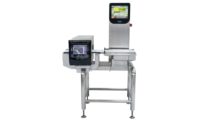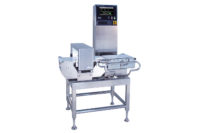Save food waste and floor space: Fortress launches new combination metal detector and checkweigher
Fortress engineered the Raptor series for food processors operating in high care sectors.

Simple to use, robust and hygienic, the Raptor Combination is Fortress Technology’s first fully integrated checkweigher and metal detector. Winner of Food Processing’s Lean Manufacturing award in 2021, the machine was commended by European judges for its “innovation and useful range of food production solutions.”
Now available in the U.S. and Canada, in addition to offering cost savings for end-users at the best quality at a competitive price, the intuitive Raptor Combination machine captures and reports all the data required to guarantee food brand integrity and absolute traceability.
Available in four standard belt widths—100, 200, 300 and 400 millimeters—Fortress engineered the Raptor series for food processors operating in high care sectors, including packaged meats and fish, and ready-to-eat meals. Including innovative technology features at a competitive price point, the Raptor Combination also solves several previous issues that the combination inspection market has, until now, failed to address. Notably, features include accurate inspection and weight checking of products and pack formats weighing from 50 grams up to 8 kilograms (1.76 ounces up to 17 pounds) and measuring up to 400 millimeters in length.
Reducing food giveaway
With input costs impacting already fragile margins in all food sectors, increasing output and boosting machine reliability can help to control rising manufacturing costs.
Regional Sales Manager Eric Garr explains, “In checkweighing systems, reliability and accuracy are essential to address machine downtime, comply with local regulations, and minimize product giveaway. Due to its robust stainless-steel frame coupled with transparent covers and engineered cutouts to prevent airflow impacting weighing accuracy, our Raptor series reduces effects from the factory environment, minimizing the issue of false weight readings.”
Utilizing feedback from the DC brushless motors and optical sensors, the system operates at high speeds for rapid and precise weight checks of individual packs in real time, all while tracking products as they move transversely across the system. The modular electronics also have the optional ability to provide feedback upstream to filling, portioning and packing automation equipment, signaling when to increase or decrease fill quantity.
To optimize quality control and reduce the risk of costly metal contaminant recalls, the Raptor Combination system integrates a precision Fortress Stealth or Interceptor metal detector to inspect packaged food products.
The Conveyor Run-Only Mode is another unique and innovative Raptor feature. For processors that are producing non-weight-controlled products, or in the unlikely event of a checkweigher hardware failure, this enables manual control of the belts and run the metal detector with independent control of its reject and reject monitoring, explains Garr. “We know that our customers can still ship product without a checkweigher but, product cannot ship if it has not been inspected for potential metal contamination," Garr says.
Two lockable reject bins separate weight and metal contaminant rejects. “Locating the reject bins on opposite sides of the system keeps the machine footprint as compact and short as possible. However, every factory is different, and the customer has a choice in the layout of the bins whether opposing or sequential”, adds Garr.
Exceeding compliance requirements
Each Raptor Combination machine is equipped with 500 product settings, which can be expanded if required. Additionally, the machine features a single-point, intuitive HMI and live statistical data. Quality and production managers can easily view live OEE data that is most relevant to their operation. By generating constant feedback on operational statistics such as volume, weight and speed, decisions can be made on the fly, increasing operational efficiency.
When routine quality assurance machine tests are due—typically hourly—a visual alert is issued. Steps cannot be omitted. If not performed to the set parameters, this is also flagged by the machine and, in any metal detection data collated by the optional Contact 4.0 web appliance, a turnkey reporting solution. For increased flexibility, there’s also the option to add Communication Adapters such as Ethernet/IP, as well as OPC UA that producers can use to tailor the live data collected for their own database.
Instant HACCP and COP compliance was a key rationale for Dutch food processor Soupy choosing the Raptor Combination machine. Soupy director Jan Schipper explains, “We especially value the pre-set automatic test procedures that provides feedback to our quality manager. It automatically meets the requirements set by large retail chains.”
Highest hygiene specifications
Inspecting product rates exceeding 150 parts-per-million, the Raptor Combination Metal Detector and Checkweigher also introduces a hygienic easy-clean conveyor.
Overcoming the longstanding industry challenge of loosening belt tension during machine sanitation, in just seconds food operators can disconnect the conveyor motor cable with a quarter turn of the connector and lift out the entire conveyor assembly for maintenance and cleaning. Belts are de-tensioned with a robust and cleverly designed removable idle roller assembly. Belt tension and alignment are instantly restored when the idle roller assembly is put back in place. This clever no-tools concept saves time and increases hygiene.
Schipper summarizes why this was so critical for his food firm. “Good cleanability was a basic requirement," Schipper says. "Electronics, sensors … they can be sensitive to water, but we still need to be able to clean the machine and belt perfectly, while everything continues to work as it should.”
Freeing up floor space
The market for combination inspection equipment is being propelled by the need to save space and reduce waste, claims Garr. One of the easiest ways in which companies can save line space is to opt for a combined metal detection and checkweighing system—mounting these systems on the same conveyor results in a smaller footprint than combined stand-alone units would occupy.
“You can’t get away from the fact you need separate rejects for weighing and metal as the rework required for rejected products is very different. However, Fortress has designed the Raptor Checkweigher so it can utilize opposing rather than sequential rejects. This helps to reduce the length of the reject system by nearly 20 inches,” says Garr. The Fortress Raptor Combination Metal Detector and Checkweigher can start at 1.7 meters in overall length.
Garr concludes, “The food industry will continue to demand inspection systems with ever more compact dimensions. Whilst technological progress will continue to forge ahead in this area, there comes a point when both physics and the need to guarantee product quality, place limitations on reducing system size. It is about finding that sweet spot, where footprint, inspection reliability and cost of ownership can all be balanced.”
Source: Fortress Technology Ltd.
Looking for a reprint of this article?
From high-res PDFs to custom plaques, order your copy today!








